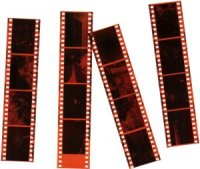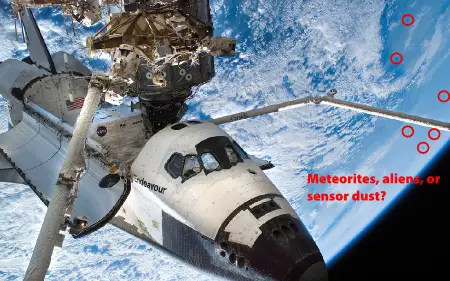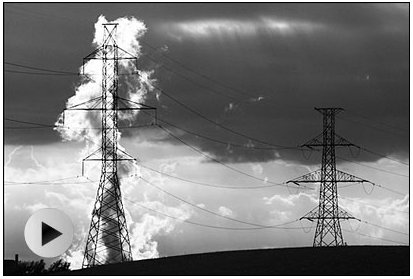From the markings on the barrels, these appear to be lenses made by JML Optical. It shows how painstaking it is to make high quality lenses. I thought it was interesting to see the strange mix of high-tech (vacuum chambers and electron beams) and low-tech (wooden sticks and plastic cups) manufacturing methods used in the production of one lens.
admin
John Watson is the original founder of Photodoto. If you're interested in what John has been up to, you can browse his personal blog.
Airsick: Short film from 20,000 still images
As part of its Earth Hour feature, The Toronto Star is hosting a short film created to highlight human impact on the environment and specifically on the air we breathe.
Twenty days. Twenty thousand still images. A single message. Toronto Star photographer Lucas Oleniuk captures the issue of global warming in a video created entirely by using still images.
Because it was made with still images, the entire film consists of time-lapse sequences. It’s a beautiful example of time-lapse photography. Photojojo recently did a good tutorial on time-lapse you should check out if you are interested in giving it a try.
… Continue reading Airsick: Short film from 20,000 still images
Free noise reduction plugin for the GIMP
 I’ve been using the GIMP image editor (also known as the GNU Image Manipulation Program) (also known as the wonderful, open source, free photo editor with the awful name) a lot lately. Version 2.4.2. I highly recommend a second look if you haven’t tried it recently. The newest version has vastly improved controls for cropping and selections, a foreground selection tool, a healing tool, and better brush management among other enhancements.
I’ve been using the GIMP image editor (also known as the GNU Image Manipulation Program) (also known as the wonderful, open source, free photo editor with the awful name) a lot lately. Version 2.4.2. I highly recommend a second look if you haven’t tried it recently. The newest version has vastly improved controls for cropping and selections, a foreground selection tool, a healing tool, and better brush management among other enhancements.
But one thing my stock GIMP install didn’t have was a decent noise removal filter. That is, until I downloaded and installed the GREYCstoration plugin. Installing it is as simple as downloading and dropping the plugin into the GIMP plugins directory. Restart GIMP and you’ll find a new menu under Filters | Enhance | GREYCstoration.
Take better flash photos in one easy step
Many people shy away from flash photography because it makes people look bad. Photographs taken with a flash can leave harsh shadows that highlight every wrinkle, turn skin blue, shine a flood light at thinning hair, create hot spots on the forehead, nose and cheeks, and generally make subjects look unattractive. But when there isn’t enough light, sometimes your only choice is to use a flash or not take photos at all.
Well, I’m here to tell you that your flash photos indoors can look amazing. And here’s how…
… Continue reading Take better flash photos in one easy step
I’m ready for my closeup: 6 methods for perfectly focused self-portraits
Self-portrait shooters usually rely on the trial-and-error method of focusing. Shoot, shoot, and shoot again until the perfect combination of pose, exposure, and focus are achieved. But there is a better way (several, in fact)! All of these methods are quick and easy and will give you accurate focusing without a lot of frustrating trial and error.
Before you begin, you’ll just need to acquaint yourself with how to put your camera into manual focus mode. You won’t actually use manual focus for focusing—you’ll just use it to keep the focus once you’ve got it set just the way you want. For each of the methods below (except the last one), you’ll auto-focus first and then set the camera to manual focus so that it won’t attempt to re-focus when you take the shot. You’ll also find that having a remote shutter release helps immensely.
… Continue reading I’m ready for my closeup: 6 methods for perfectly focused self-portraits
Why are my photos of moving subjects blurry?
There are two primary kinds of blur in photos (well, three, but we’ll assume you keep your camera fairly clean): focus blur and motion blur. Here are examples of focus and motion blur, respectively (click to enlarge):
Focus blur happens when the subject of your photo is simply out of focus. The solution to that is to make sure your autofocus is on and try again. If it’s out of focus, re-focus and shoot again. Pretty straightforward. On point and shoot cameras, the most likely reason you’re out of focus is because the subject moved or the smart focusing system wasn’t so smart and focused on the wrong object.
Motion blur, on the other hand, doesn’t happen because your subject is out of focus. It happens because your subject is moving relative to the camera frame while the exposure is being made AND the shutter speed isn’t fast enough to freeze it. Let’s tackle those two aspects separately.
… Continue reading Why are my photos of moving subjects blurry?
Photography and magic and Nikon CLS
A friend of mine calls me up every week or so with a photography question. Usually, he’s looking for the magic incantation or editing technique that will make his photos turn out in a particular way. Sometimes there is such a thing (e.g. wait for the the flash to charge, use manual focus, etc.). But usually there isn’t. Usually, getting a particular effect in a photograph, either at the camera or in post-production, requires experience, artistry, experimentation, and work. And a lot of the stuff you learn on one photo can’t just be applied blindly to the next one. School portraits aside (ha!), every photo is different.
Converting Film Negatives to Digital with ScanDigital.com
 If you’re anything like me, you’ve probably got a shoebox (or maybe even a slightly more elaborate storage system) full of old negatives from your film days. I’ve been casually thinking about scanning some of my old negatives and especially the negatives from my wedding to preserve them. Negatives can be stored for decades but I don’t store mine in anything near ideal conditions. In theory, digital images can be stored forever (assuming you’ve got a good backup process in place… you do backup your files, don’t you?)
If you’re anything like me, you’ve probably got a shoebox (or maybe even a slightly more elaborate storage system) full of old negatives from your film days. I’ve been casually thinking about scanning some of my old negatives and especially the negatives from my wedding to preserve them. Negatives can be stored for decades but I don’t store mine in anything near ideal conditions. In theory, digital images can be stored forever (assuming you’ve got a good backup process in place… you do backup your files, don’t you?)
The trouble with scanning negatives is that it’s cumbersome and, if you care about the quality, the equipment can be quite expensive. Your average consumer-grade desktop scanner with negative scanning unit will do in a pinch but it won’t match anything near the quality or speed of a dedicated negative scanning machine. And you’ve still got to deal with dust and scratches on the negatives which must be cleaned and inspected and… well, you get the idea. It’s a pain.
So I was pleased to hear about a service called ScanDigital.com (www.scandigital.com) which aims to takes all of the hassle and pain out negative scanning.
… Continue reading Converting Film Negatives to Digital with ScanDigital.com
DSLRs, sensor dust, and NASA
If you haven’t seen these photos from a recent Shuttle mission you should definitely check them out. Spectacular. But, me being who I am, I couldn’t help but notice the sensor dust defects in the fifth photo. You can tell it’s dust on the sensor because it shows up again in the same places on the seventh photo which is also shot at a high f-stop (where sensor spots are more likely to appear) (and you can tell it’s a high f-stop because everything in the frame is in sharp focus.).

I should probably get out more.
I can’t wait until it’s feasible for private citizens to go on Earth orbit “safaris.” I’ll definitely make sure my sensor is clean before hand. 😉
Digital Photography Podcasts
![]() Here’s a roundup of some good photography podcasts I’ve noticed recently. These podcasts cover the gamut from photography lessons, to gear reviews, interviews, Photoshop tutorials, discussions of fine art, and a lot more.
Here’s a roundup of some good photography podcasts I’ve noticed recently. These podcasts cover the gamut from photography lessons, to gear reviews, interviews, Photoshop tutorials, discussions of fine art, and a lot more.
What’s a podcast, you ask? In a nutshell, they’re internet radio programs that you can subscribe to for free and listen to on your computer or mp3 player. Click here for more information about podcasts. You can subscribe to these using iTunes or other podcatching applications (I use Miro) or even just your normal RSS feed reader.
I’m a regular listener of Tips from the Top Floor and The Digital Photography Show. They’re both great shows and are fun to listen to.
Leave a comment if you know of other photography related podcasts that you think are worth listening to.
to start
making profit!












